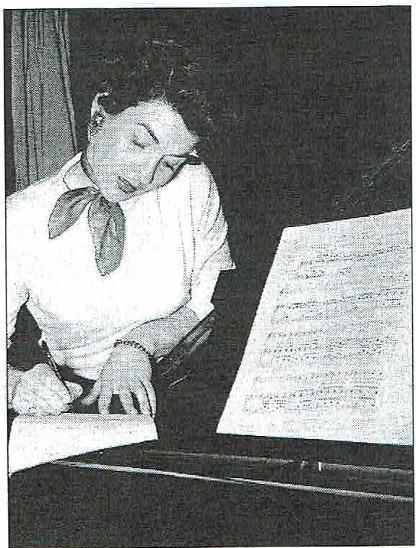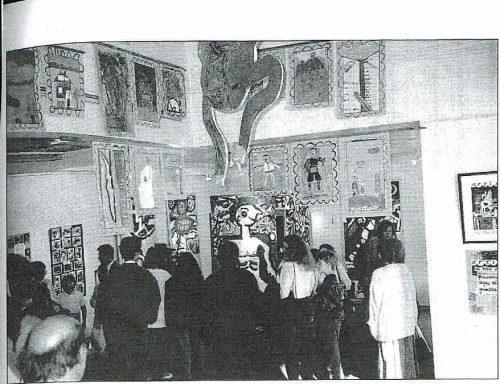“… The ability to think creatively may well be the greatest need of our day … it is ridiculous to think that we can ignore creative thinking and creative expression throughout the child’s elementary and secondary schooling and still hope to find these qualities in the adult.”
– Wynona Mulcaster, in the Community Arts Council News, May 1959.
In 1954, members of the Arts Council and President Mary Roaf felt that students in the public school system were lacking exposure to the arts. Phillipa Polson of West Vancouver had initiated an arts education program in schools there in 1952. She approached the Vancouver Arts Council to take it over. With assistance from a Leon and Thea Koerner Foundation grant, the Arts Council devel¬oped a program called Artists for Schools. Requests by teachers and school principals for the program increased through the years, as did the distinguished participating artists, musicians, actors, architects, poets, writers, painters, and potters, many of whose names are now legend. These artists willingly gave of their time and talents for a modest $25 hon¬orariam, talking to classes, demonstrating their particular craft and giving lunchtime performances in school auditoriums.
Ten years later the program had expand¬ed to become a project involving many Arts Council volunteers in its administration. Each class received an evaluation form to be filled out by the class teacher and the pupils, while artists likewise evaluated each school visit. All the comments, when received by the Arts Council, were carefully noted. Over this peri¬od the number of schools wishing to be included had grown to ninety-five and fund¬ing became increasingly difficult, to the point where finally, in 1965, the board felt the pro¬gram was no longer affordable.
Twenty-five years after the end of the original Arts Council program, corporate support allowed the Arts Council to carry out a new program in the visual arts. In 1989, with the title Artists in the Schools, the Arts Council initiated a visual arts program giving assistance to schools’ art teachers. The purpose of this program, which is still active, is to enrich art classes by offering the benefit of a professional working artist as a resource for students in the classroom. The Arts Council gallery has proved to be an ideal space for exhibiting the fascinating results of these collaborative efforts, all of which serve as a tribute to the advances that can and have been made in art education programming. A grant of up to $500 is awarded to each successful project as an honorariam to the artist involved. Based on funds available, the number of projects chosen varies from year to year. The program was started with support from Chevron Canada, the Leon and Thea Koerner Foundation, the Hamber Foundation and the Provincial Cultural Services Branch. Today it continues to rely on the generosity of corporate partners such as Chevron Canada.


In January 1978, the National Task Force on Arts and Education of the Canadian Conference of the Arts launched a national inquiry into the arts in the Canadian educa¬tion system. As part of this inquiry, the B.C. Committee on Arts and Education was estab¬lished in the spring. This steering committee was responsible for collecting information on the arts and education in B.C., compiling a report and making recommendations. For funding purposes, the committee was under the aegis of the Vancouver Arts Council, and in the fall of 1980, with a provincial grant, it produced What’s the Fuss? A Community Arts Campaign Kit, a lobbying guide for strengthening the role of arts in education. Subsequently, in order to maintain the momentum and enthusiasm, the steering committee formed the Western Council for Arts in Education Associations, an organiza¬tion which continues to operate today as the B.C. Arts in Education Council. Currently the provincial government and the Vancouver Foundation fund projects to enrich the teach¬ing of arts in schools throughout B.C..

A recent exhibition of the work of students involved in the Artists in the Schools program.
Some Artists for Schools and Artists in the Schools:
- Amir Alibhai, multi-media artist
- Harry and Francis Adaskin, musicians
- Milla Andrew, singer
- John Avison, musician
- Alex Baillie, installation artist
- Bert Binning, painter
- Earl Birney, poet
- Molly Bobak, painter
- Elaine Brewer-White, sculptor
- Greta Brunow Guzek Stan Clarke, potter
- Robert Clothier, actor, sculptor
- Joy Coghill, actress
- Cynthia Connor, fabric artist
- Jean Coulthard, composer
- Sally Creighton, writer
- Barbara Custance, pianist
- Alison Diesvelt, visual artist
- Arthur Erickson, architect
- Theresa Gaiters, paper maker
- Brent Gloeckler, potter
- Martin Guderna, visual artist
- Rick Harry, print and mask maker
- Ardelle Hawkes, painter
- Don Jarvis, artist
- Gerald Jarvis, musician
- Mia Johnson, painter
- Ian Kennard, potter
- Anika Kiss, photographer
- Sam Kwan, potter
- Fred Lasserre, architect
- Dorothy Livesay, poet
- John Love, multi-media artist
- J.A.S. McDonald, painter
- Davide Pan, multi-media artist
- Laurie Papou, painter
- Betty Phillips, singer
- Lloyd Powell, pianist
- Ernie Prentice, singer
- Paddy Proniuk, painter
- Bill Reid, sculptor
- Jack Shadbolt, painter
- Lister Sinclair, writer
- Louise Slobodan, fabric artist
- Gordon Smith, painter
- Paul Judson Stobbe, photographer
- Richard Tetrault, printmaker
- Playhouse Theatre Co.
- Ron Thom, architect
- Ian Thome, actor
- Bernard Turgeon, singer
- Stuart Wenschlag, animator
- Ethel Wilson, writer
- George Woodcock, writer
- Joyce Woods, artist